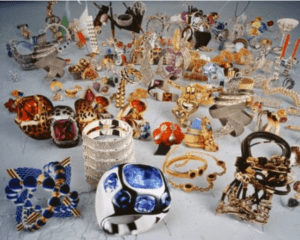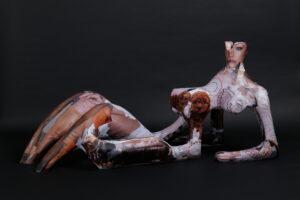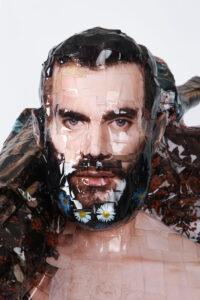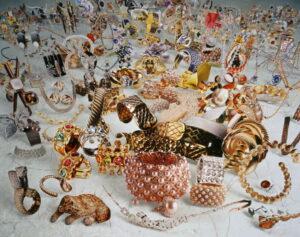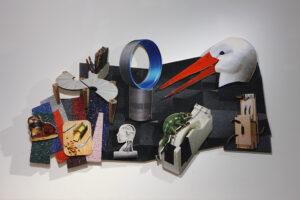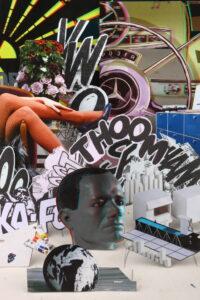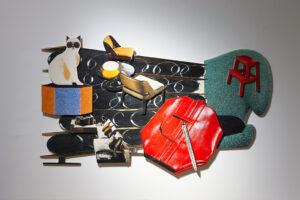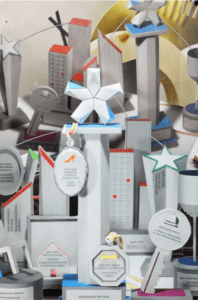





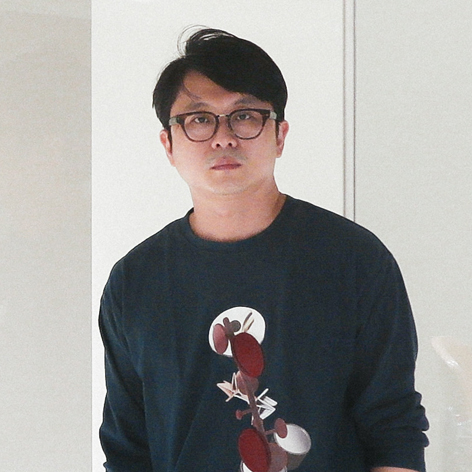
Gwon Osang graduated from Hongik University’s Department of Sculpture in 2000 and obtained a master’s degree from the Department of Sculpture at the same graduate school in 2004. From 2005 to 2022, he has been working as an exclusive artist at Arario Gallery, one of the major galleries in Korea.
He is an artist who shows the new meaning and the way of being in contemporary sculpture through photography. He shows a completely different perspective and approach from the traditional sculpture by reproducing physical elements such as materials, shapes, and textures with a camera.
In short, He explores sculpture itself with a different medium and methodology as a meta-sculptor.
- Works for Sale
- Artistic Career
- World of Work
- Activity
Deodorant Type with Photo Sculpture
Deodorant Type with Photo Sculpture
Solo Exhibitions (Brief)
Gwon exhibited <540 Statements About Twins> at the group exhibition 《Vacuum Packed》 (1999) held at Alternative Space Loop (Seoul, Korea), the first private non-profit organization in Korea. This work is meaningful in that it is the artist’s first ‘photo sculpture’.
In 2001, he held his first solo exhibition, 《Deodorant Type》, at Insa Art Space (Seoul, Korea), the first public non-profit organization in Korea. From this time on, Gwon’s ‘photo sculpture’ began to be known in earnest.
From 2005 to 2007, he exhibited actively on the international stage, including Andrew Shire Gallery in LA (LA, USA), Union Gallery (London, UK), and Arario Beijing (Beijing, China).
In particular, in 2008, he held a solo exhibition at the invitation of Manchester Art Gallery (Manchester, England), one of the major art museums in the UK. This exhibition received a great response by presenting a total of 14 works, including new works produced while staying in Manchester for one month. Through this exhibition, Osang Gwon was recognized for his skills on the international stage, and it was a good opportunity to carry out more international activities, such as producing an album cover for the rock band KEANE.
In 2011, he exhibited Ando Fine Art in Berlin (Berlin, Germany), and moved into Doosan Residency New York, a non-profit organization operated by Doosan Group, one of the leading companies in Korea, and held a solo exhibition (2011) at Doosan Gallery New York. A full-fledged overseas expansion has taken place.
Since after 2012, he has been actively exhibiting around the world, including Norway, Singapore, Paris, Japan, and Australia.
Group Exhibitions (Brief)
Gwon Osang has been active in the scene since the early days of his work, receiving a lot of attention and interest. In the 2000s, when the world art world was booming, he was invited to numerous special exhibitions held at major national and international art museums, corporate art galleries, and major galleries.
For example, 《Young Artists from Korea, China and Japan》 held at the National Museum of Modern and Contemporary Art in 2004 was a meaningful exhibition examining the presence of Asian contemporary art through the works of young artists representing Korea, China and Japan.
The exhibition 《Korean Eye: Fantastic Ordinary》 held at Saatchi Gallery in London (2010) was an exhibition that invited young Korean artists. This exhibition introduced young Korean artists, who were very noteworthy at the time, to London, the center of European contemporary art.
In addition, 《Present Tense》, 2010, National Portrait Gallery Canberra, Canberra, Australia, 《Collector’s Stage》, 2011, Singapore Art Museum, Singapore, 《On Manner of Forming》, 2012, Edwin Gallery2, Jakarta, Indonesia. The artist participated in numerous domestic and international special exhibitions, such as the 20th anniversary of the opening of the Gwangju Museum of Art 《Jin.Tong. Korean Contemporary Art since 1990》,《Tech 4 Change》, 2015, Best Forssen, Norway, has demonstrated its capabilities.
Awards (Selected)
The artist was awarded the 27th ‘Kim Sechoong Youth Sculpture Award’. ‘Kim Sechoong Youth Sculpture Award’ is a statue created in commemoration of the artist’s life after the death of sculptor Kim Sechoong.
In 1990, the award categories were subdivided and ‘Kim Sechoong Youth Sculpture Award’ was established for young sculptors under the age of 40. The artist won the award in 2013 through the ‘Deodorant Type’ series.
Collections (Selected)
Gwon Osang’s works are in the collections of not only national, public and private art museums in Korea, but also major art galleries abroad.
Major domestic collections include the National Museum of Modern and Contemporary Art (Seoul, Korea), Leeum Samsung Museum of Art (Seoul, Korea), Seoul Museum of Art, Busan Museum of Art, Art Sonje Center, and Leeum, as well as major national and public art museums representing Korea. CI KIM, one of the collectors, also owns several works.
Overseas, prominent art galleries and private collectors such as David Roberts Art Foundation, The Zabludowicz Collection (London, UK), Burger Collection, Universal Music Group, and Singapore Museum own Gwon Osang’s works.
Deodorant Type with Photo Sculpture
Deodorant Type with Photo Sculpture
Originality & Identity
The artist Gwon Osang got a reputation as a representative of ‘Photo-Sculpture’. In addition to the sculptor François Willème, who created the term ‘Photo-Sculpture’ in 1863, the artistic trials to combine 2-dimensional photography with 3-dimensional sculpture are found in artistic experiments of collaborating photography and sculpture in the 1960s and 1970s. However, Gwon Osang perfectly fused with the sculpture and photography as a focal point of the up-to-date genre, the artist Gwon had newly created. Thereby the expansion of the boundaries of contemporary art is to be continued.
Gwon Osang literally makes sculptures with photos. ‘Flatness’ and ‘lightness’ are the right expressions to explain the characters of the materials of the sculptures so that the clusters with photo pieces are shown as a whole. In the early period of the ‘Deodorant Type’, advocating the slight and sleek pieces of its feature, it was prone to focus on the photo mechanism. Afterwards, there exist the fundamentals through the series he produced. This redefined the meaning of conventional sculpture understanding (named ‘The Sculpture’) and asked about the relations between sculpture and spaces (named ‘New Structure’).
Thereafter the artist Gwon actively adopted carving methodology (named ‘relief’) or studied patterns of the basic notion of the sense of volume and mass (named ‘Mass Patterns’). Namely, the most important focal point is in ‘carving’, even though both photos and sculptures are crucial in his artworks.
“The fundamentals, I am totally into the story of ‘How human beings have been living by carving’.”
His representative works are shown like ‘Deodorant Type,’ ‘The Flat,’ ‘New Structure,’ ‘Relief’, ‘Mass Patterns,’ etc, which mostly emphasize formativeness used by downloaded images from the internet. These are in progress randomly, and growing by influencing in between series.
The thing for which Gwon Osang, as a modern carving sculptor, wants to make a voice is ‘NOW’ in the current era where everyone is living. The artist contemplates how many perspectives to read when designing a work, enlarging the narrative of objects and humans’ possibilities of carving and art in the current era.
Style & Contents
The preliminary materials of Gwon Osang’s artworks are photo images. However, the process of making a 3-dimensional object as well as what finished artwork is nothing less than a sculptural work. An automobile shaped object is composed of a bronze sculpture finishing in-real shape only with image information and painted with acrylic paint; titled – The Sculpture. It is an experimental attempt by configuring random objects into clustered objects expressing a new form of mass – Mass Patterns. These artworks represent clearly that artist Gwon Osang’s production.
Ultimately, a crucial point of art is most artworks are transformed and expanded sustainably under the core goal of exploring the formativeness of new paradigm transformation.
The method and process of the artist, Gwon, is a style of exhibiting space and utilising the pedestal display. This is a quite unique aspect of his artwork. For instance, in his current work, multiple exhibits tilted form-like objects such as < A Family Photo of 440 Pieces Composed of Tenacity >(1998-1999). The work < Hockney >(2013) is displayed as it stands with the Hockney’s Swimming Pool series. In 2008, Osang Gwon’s sole exhibition 《Deodorant Type: Sculpture by Osang Gwon》 was held at the Manchester City Museum 2008. The cubistic styling for exhibition curation and the impact of artworks are supreme by 3-dimensional space with different heights of pedestals.
In Gwon Osang’s recent exhibition, the creative exhibition is illustrated with various series of works matching with space like a movie set, collaborating a creative group OUR LABOUR, named 《OUR SET: OUR LABOUR x GWON OSANG》(2022, Su-won Artspace, at Su-won Korea). He showed off a new notion of exhibition unusual in a conventional art gallery.
The symbolic value of Gwon Osang’s artwork is shown in his displaying style in different exhibiting places. It regards various curation settings giving elements explaining the relationship between the arts and the viewers. This is a focal point where Gwon Osang’s work is interpreted by audiences openly.
Constancy & Continuity
Gwon Osang’s reputation with his artwork is emerging as a new position in Korea’s Contemporary Art. He grew up with the domestic contemporary art history paradigm. There were boom years when the Korean contemporary art market and the global contemporary art market exponentially increased in the 2000s. The Korean art market was lacking compared to the western one, however, it was full of great possibilities to shade grey areas for new artists.
Meanwhile, Gwon Osang made his debut with the 1st alternative room for authorizing important roles for the current art world. He exhibited his debut work named 《Vacuum Packaging》(1999, Seoul) in the alternative loop group exhibition. Some critics commented “A quicker, more sophisticated, and perfect debut than any others.” – Han Seung RYU. This underlines that Gwon Osang has received great attention and reputation since his debut, and his artworks have been uplifted from the art market.
Thereafter, he worked as an exclusive artist at Kukje Gallery and Arario Gallery, and overgrown domestic and international art galleries and biennales. It has a significant meaning that both the artist and art industry grew mutually in this era, and led to the transformation of the Korean contemporary art paradigm.
The uniqueness and importance of Gwon Osang’s art world have gotten a large spotlight abroad. His works brought a crucial mark on art history in terms of expanding the boundaries of sculpture while reflecting the reality of modern society. Further, his work has been introduced in both eastern and western countries, including Japan, France, Italy, and the Netherlands. The representative examples are the 2008 Asia Triennale held in England and a solo exhibition at the Manchester Museum of Art in the UK.
Participating in a short-term residency program in the UK made connections with officials from the UK x Asia Triennial Manchester. Since then, Gwon Osang also launched a relationship with the Manchester City Museum. This received great attention, drawing up to 870 visitors in a day. There were 14 pieces of ‘Deodorant Type’ displayed, and from 2008 to 2009, the number of visitors to the museum was about 420,000. This figure represented that his artwork got a great spotlight in the UK.
At that time, as a young and newborn artist without any special connection to England, Gwon Osang smashed the largest art market with his art pieces in the UK. Underlying the meaning of art’s historical value provides supporting evidence with only his artworks.
Deodorant Type with Photo Sculpture
Deodorant Type with Photo Sculpture
Deodorant Type with Photo Sculpture
Deodorant Type with Photo Sculpture
- Works for Sale
- Artistic Career
- World of Work
- Activity
Deodorant Type with Photo Sculpture
Deodorant Type with Photo Sculpture
Solo Exhibitions (Brief)
Gwon exhibited <540 Statements About Twins> at the group exhibition 《Vacuum Packed》 (1999) held at Alternative Space Loop (Seoul, Korea), the first private non-profit organization in Korea. This work is meaningful in that it is the artist’s first ‘photo sculpture’.
In 2001, he held his first solo exhibition, 《Deodorant Type》, at Insa Art Space (Seoul, Korea), the first public non-profit organization in Korea. From this time on, Gwon’s ‘photo sculpture’ began to be known in earnest.
From 2005 to 2007, he exhibited actively on the international stage, including Andrew Shire Gallery in LA (LA, USA), Union Gallery (London, UK), and Arario Beijing (Beijing, China).
In particular, in 2008, he held a solo exhibition at the invitation of Manchester Art Gallery (Manchester, England), one of the major art museums in the UK. This exhibition received a great response by presenting a total of 14 works, including new works produced while staying in Manchester for one month. Through this exhibition, Osang Gwon was recognized for his skills on the international stage, and it was a good opportunity to carry out more international activities, such as producing an album cover for the rock band KEANE.
In 2011, he exhibited Ando Fine Art in Berlin (Berlin, Germany), and moved into Doosan Residency New York, a non-profit organization operated by Doosan Group, one of the leading companies in Korea, and held a solo exhibition (2011) at Doosan Gallery New York. A full-fledged overseas expansion has taken place.
Since after 2012, he has been actively exhibiting around the world, including Norway, Singapore, Paris, Japan, and Australia.
Group Exhibitions (Brief)
Gwon Osang has been active in the scene since the early days of his work, receiving a lot of attention and interest. In the 2000s, when the world art world was booming, he was invited to numerous special exhibitions held at major national and international art museums, corporate art galleries, and major galleries.
For example, 《Young Artists from Korea, China and Japan》 held at the National Museum of Modern and Contemporary Art in 2004 was a meaningful exhibition examining the presence of Asian contemporary art through the works of young artists representing Korea, China and Japan.
The exhibition 《Korean Eye: Fantastic Ordinary》 held at Saatchi Gallery in London (2010) was an exhibition that invited young Korean artists. This exhibition introduced young Korean artists, who were very noteworthy at the time, to London, the center of European contemporary art.
In addition, 《Present Tense》, 2010, National Portrait Gallery Canberra, Canberra, Australia, 《Collector’s Stage》, 2011, Singapore Art Museum, Singapore, 《On Manner of Forming》, 2012, Edwin Gallery2, Jakarta, Indonesia. The artist participated in numerous domestic and international special exhibitions, such as the 20th anniversary of the opening of the Gwangju Museum of Art 《Jin.Tong. Korean Contemporary Art since 1990》,《Tech 4 Change》, 2015, Best Forssen, Norway, has demonstrated its capabilities.
Awards (Selected)
The artist was awarded the 27th ‘Kim Sechoong Youth Sculpture Award’. ‘Kim Sechoong Youth Sculpture Award’ is a statue created in commemoration of the artist’s life after the death of sculptor Kim Sechoong.
In 1990, the award categories were subdivided and ‘Kim Sechoong Youth Sculpture Award’ was established for young sculptors under the age of 40. The artist won the award in 2013 through the ‘Deodorant Type’ series.
Collections (Selected)
Gwon Osang’s works are in the collections of not only national, public and private art museums in Korea, but also major art galleries abroad.
Major domestic collections include the National Museum of Modern and Contemporary Art (Seoul, Korea), Leeum Samsung Museum of Art (Seoul, Korea), Seoul Museum of Art, Busan Museum of Art, Art Sonje Center, and Leeum, as well as major national and public art museums representing Korea. CI KIM, one of the collectors, also owns several works.
Overseas, prominent art galleries and private collectors such as David Roberts Art Foundation, The Zabludowicz Collection (London, UK), Burger Collection, Universal Music Group, and Singapore Museum own Gwon Osang’s works.
Deodorant Type with Photo Sculpture
Deodorant Type with Photo Sculpture
Originality & Identity
The artist Gwon Osang got a reputation as a representative of ‘Photo-Sculpture’. In addition to the sculptor François Willème, who created the term ‘Photo-Sculpture’ in 1863, the artistic trials to combine 2-dimensional photography with 3-dimensional sculpture are found in artistic experiments of collaborating photography and sculpture in the 1960s and 1970s. However, Gwon Osang perfectly fused with the sculpture and photography as a focal point of the up-to-date genre, the artist Gwon had newly created. Thereby the expansion of the boundaries of contemporary art is to be continued.
Gwon Osang literally makes sculptures with photos. ‘Flatness’ and ‘lightness’ are the right expressions to explain the characters of the materials of the sculptures so that the clusters with photo pieces are shown as a whole. In the early period of the ‘Deodorant Type’, advocating the slight and sleek pieces of its feature, it was prone to focus on the photo mechanism. Afterwards, there exist the fundamentals through the series he produced. This redefined the meaning of conventional sculpture understanding (named ‘The Sculpture’) and asked about the relations between sculpture and spaces (named ‘New Structure’).
Thereafter the artist Gwon actively adopted carving methodology (named ‘relief’) or studied patterns of the basic notion of the sense of volume and mass (named ‘Mass Patterns’). Namely, the most important focal point is in ‘carving’, even though both photos and sculptures are crucial in his artworks.
“The fundamentals, I am totally into the story of ‘How human beings have been living by carving’.”
His representative works are shown like ‘Deodorant Type,’ ‘The Flat,’ ‘New Structure,’ ‘Relief’, ‘Mass Patterns,’ etc, which mostly emphasize formativeness used by downloaded images from the internet. These are in progress randomly, and growing by influencing in between series.
The thing for which Gwon Osang, as a modern carving sculptor, wants to make a voice is ‘NOW’ in the current era where everyone is living. The artist contemplates how many perspectives to read when designing a work, enlarging the narrative of objects and humans’ possibilities of carving and art in the current era.
Style & Contents
The preliminary materials of Gwon Osang’s artworks are photo images. However, the process of making a 3-dimensional object as well as what finished artwork is nothing less than a sculptural work. An automobile shaped object is composed of a bronze sculpture finishing in-real shape only with image information and painted with acrylic paint; titled – The Sculpture. It is an experimental attempt by configuring random objects into clustered objects expressing a new form of mass – Mass Patterns. These artworks represent clearly that artist Gwon Osang’s production.
Ultimately, a crucial point of art is most artworks are transformed and expanded sustainably under the core goal of exploring the formativeness of new paradigm transformation.
The method and process of the artist, Gwon, is a style of exhibiting space and utilising the pedestal display. This is a quite unique aspect of his artwork. For instance, in his current work, multiple exhibits tilted form-like objects such as < A Family Photo of 440 Pieces Composed of Tenacity >(1998-1999). The work < Hockney >(2013) is displayed as it stands with the Hockney’s Swimming Pool series. In 2008, Osang Gwon’s sole exhibition 《Deodorant Type: Sculpture by Osang Gwon》 was held at the Manchester City Museum 2008. The cubistic styling for exhibition curation and the impact of artworks are supreme by 3-dimensional space with different heights of pedestals.
In Gwon Osang’s recent exhibition, the creative exhibition is illustrated with various series of works matching with space like a movie set, collaborating a creative group OUR LABOUR, named 《OUR SET: OUR LABOUR x GWON OSANG》(2022, Su-won Artspace, at Su-won Korea). He showed off a new notion of exhibition unusual in a conventional art gallery.
The symbolic value of Gwon Osang’s artwork is shown in his displaying style in different exhibiting places. It regards various curation settings giving elements explaining the relationship between the arts and the viewers. This is a focal point where Gwon Osang’s work is interpreted by audiences openly.
Constancy & Continuity
Gwon Osang’s reputation with his artwork is emerging as a new position in Korea’s Contemporary Art. He grew up with the domestic contemporary art history paradigm. There were boom years when the Korean contemporary art market and the global contemporary art market exponentially increased in the 2000s. The Korean art market was lacking compared to the western one, however, it was full of great possibilities to shade grey areas for new artists.
Meanwhile, Gwon Osang made his debut with the 1st alternative room for authorizing important roles for the current art world. He exhibited his debut work named 《Vacuum Packaging》(1999, Seoul) in the alternative loop group exhibition. Some critics commented “A quicker, more sophisticated, and perfect debut than any others.” – Han Seung RYU. This underlines that Gwon Osang has received great attention and reputation since his debut, and his artworks have been uplifted from the art market.
Thereafter, he worked as an exclusive artist at Kukje Gallery and Arario Gallery, and overgrown domestic and international art galleries and biennales. It has a significant meaning that both the artist and art industry grew mutually in this era, and led to the transformation of the Korean contemporary art paradigm.
The uniqueness and importance of Gwon Osang’s art world have gotten a large spotlight abroad. His works brought a crucial mark on art history in terms of expanding the boundaries of sculpture while reflecting the reality of modern society. Further, his work has been introduced in both eastern and western countries, including Japan, France, Italy, and the Netherlands. The representative examples are the 2008 Asia Triennale held in England and a solo exhibition at the Manchester Museum of Art in the UK.
Participating in a short-term residency program in the UK made connections with officials from the UK x Asia Triennial Manchester. Since then, Gwon Osang also launched a relationship with the Manchester City Museum. This received great attention, drawing up to 870 visitors in a day. There were 14 pieces of ‘Deodorant Type’ displayed, and from 2008 to 2009, the number of visitors to the museum was about 420,000. This figure represented that his artwork got a great spotlight in the UK.
At that time, as a young and newborn artist without any special connection to England, Gwon Osang smashed the largest art market with his art pieces in the UK. Underlying the meaning of art’s historical value provides supporting evidence with only his artworks.

